Caterpillars are surely among the most fascinating members of the bug world, at least when it comes to the looks. They are so diverse, colorful, and pretty that it’s hard to believe.
But did you know that some of these little cuties can also hurt you? Many species of caterpillars contain tiny little ‘hairs’ or ‘spines’. These are called setae and work very much like the prickles of a cactus.
Once you touch one of these caterpillars the tiny hairs dig into your skin causing pain and irritation. These tiny thorns actually contain toxins of various strengths, so the problems caused by getting stung by a caterpillar can vary. And finally, some caterpillars can even fling their setae at you if they feel threatened. Talk about a defense mechanism!
Does this mean it’s time to start avoiding caterpillars at all costs? Not really. Keep reading to learn more about toxic caterpillars and how dangerous they really are.
Do Caterpillars Bite?
No, caterpillars do not bite. They are capable of chewing on leaves, but not of biting through your skin. The way they can hurt us, though, is by poking you with their prickly spines. But keep in mind that this is not the case with all caterpillars. Some of them can’t even hurt you!
Are All Fuzzy Caterpillars Venomous?
So, if caterpillars use their ‘hairs’ to hurt us, does it mean that all caterpillars who have hairs are poisonous? Not necessarily! There are many species of caterpillars with spines on their bodies. Many of them are toxic, but some are not. For example, some species of caterpillars actually evolved to imitate the looks of toxic caterpillars to stay safe, even though they are actually harmless.
But, as a rule of thumb, if you see a caterpillar that’s brightly colored and has hairs/spines, it’s best not to touch it.
What Does Caterpillar Rash Look Like?
If you get stung by a toxic caterpillar, the first symptom will always be pain, redness, or itching. You might also feel a burning sensation. In most cases, this will be followed by redness of the skin. In more severe cases, swelling and blisters could also be present.
Caterpillar Stings First Aid
What to do if you get stung by a caterpillar? Well, first of all, if the caterpillar is on you, try to get it away without touching it!
The next thing to do is a simple hack that might sound too easy to be true, but it often works. You’ll want to get some adhesive tape (any kind) and stick it to the affected area. Then, pull the tape off. It might hurt a bit but the tape should get hold of the caterpillar spines and help pull them out. Repeat as many times as needed with fresh pieces of tape.
Next, you’ll want to wash the area with gentle soap and water. To help relieve the itch, you might want to use an icepack on the affected area. Alternatively, you could try a paste of baking soda and water.
A hydrocortisone cream or antihistamines might help also, but if the symptoms do not subside within a day or two, it’s best to contact a doctor for advice!
10 Toxic Caterpillar Species
There are many types of toxic caterpillars, and they can be found all across the world. That means that this list is not exhaustive. However, these are some of the most common and most fascinating venomous caterpillars:
#1 Buck Moth Caterpillar
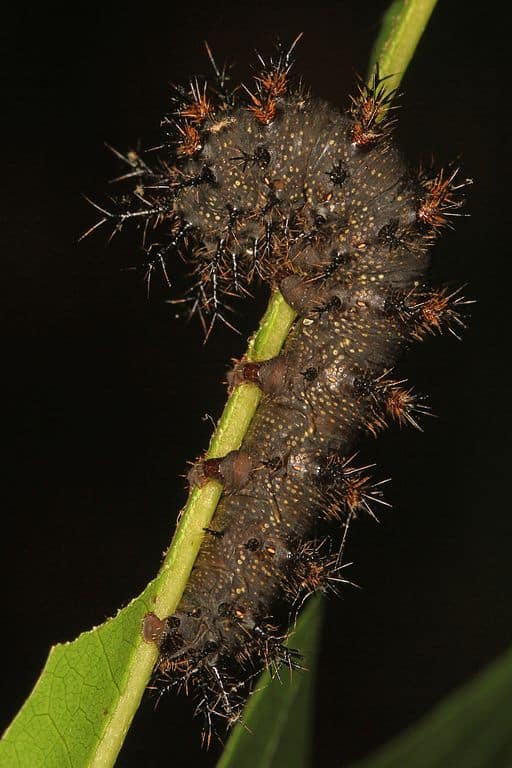
Family: Saturniidae
Scientific name: Hemileuca maia
Found in: Eastern US from Maine to Florida
Host plant: Usually oak or willow
The Buck Moth Caterpillar is one of the most common toxic caterpillars one might encounter in the US.
These caterpillars appear in 2 different forms: a light and a dark version, but the darker one (depicted above) is the one you are most likely to encounter. In that case, the caterpillar will be black with lots of white spots on it’s body.
The part that stands out the most are the tufts of “hairs” all along this caterpillar’s body. These hairs – or spines – are the Buck Moth Caterpillar’s defense mechanism.
If you get in contact with them, you’ll probably feel sudden stinging and/or pain which might be accompanied with a rash and/or swelling of the infected area. Luckily, these caterpillars usually don’t cause any serious health issues and the symptoms are usually gone within a day (although they can last up to a week in very sensitive people).
#2 Io Moth Caterpillar
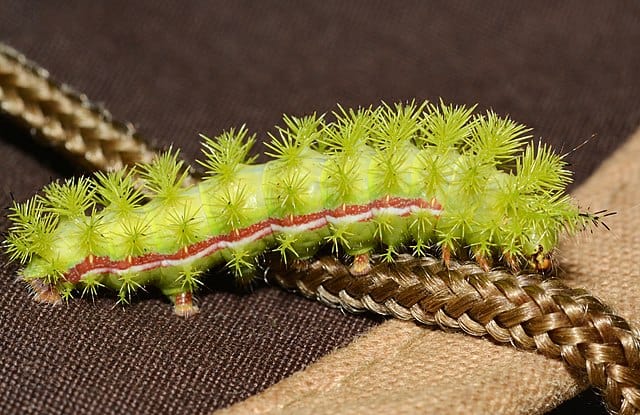
Family: Saturniidae
Scientific name: Autmeris io
Found in: Eastern US & Eastern Mexico
Host plant: Various, including elm & maple trees, hibiscus, and wisteria
You’ll easily recognize the Io Moth Caterpillar by its distinctive looks. It’s bright green, with a red & white stripe along each side. It can grow over 2 inches in length. Their prickly spines are distributed in tufts along their bodies. The spines are also bright green with black tips (but the black part might not necessarily be visible).
Can this cute caterpillar really hurt you? Well, yes they can! Their spines break of easily and can get deep into your skin. Just like with most caterpillars, you are likely to feel a sudden stinging sensation which usually lasts a couple of hours. However, Io Moth Caterpillar stings are also known to cause allergic reactions in some people which can require medical attention.
For this reason, you should closely monitor the symptoms until they are gone if you suspect you have ben stund by the Io Moth Caterpillar. Don’t panic, though, most of the time you will be just fine in a few hours!
#3 Southern Flannel Moth Caterpillar
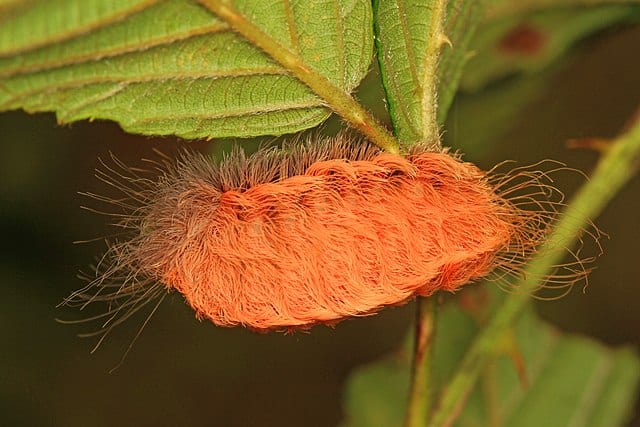
Family: Megalopygidae
Scientific name: Megalopyge opercularis
Found in: Throughout eastern US & parts of Cantral America
Host plant: Various, usually oak, elm, or citrus
This caterpillar might look cute & cuddly, but it’s actually one of the most dangerous caterpillars in North America. The caterpillar of the Southern Flannel Moth (also called the Puss Moth) does not only cause pain and redness when it stings you, but it can also cause headaches, fever, nausea, and even seizures in the affected person!
These caterpillars are easy to recognize due to their hairy bodies. Yes, their bodies are completely covered in actual hairs. Underneath those, there are pointy spines used for defense.
#4 Black-Waved Flannel Moth Caterpillar
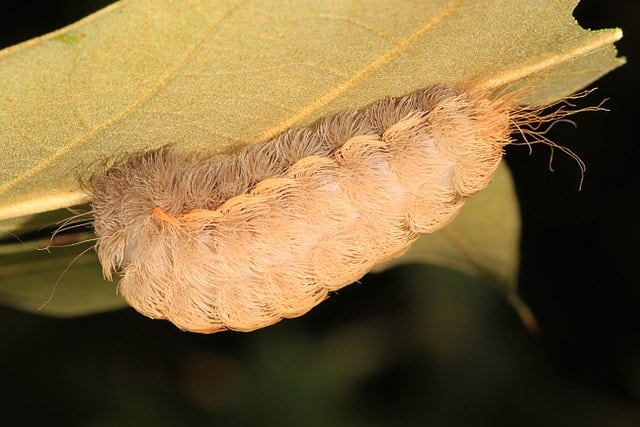
Family: Megalopygidae
Scientific name: Megalopyge crispata
Found in: Along the east coast of US
Host plant: Vaeirty of trees
The Black-Waved Moth Caterpillar looks very similar to the Southern Flannel Moth Caterpillar described above. When they are young, the Black-Waved Moth Caterpillars actually have white hairs, but they gradually grow darker over time until they reach an orange-brown color.
You are most likely to encounter this type of caterpillar in the late summer. Reportedly, the sting is not as bad as the sting of the Southern Flannel Moth Caterpillar, but can still cause considerable pain.
#5 White Flannel Moth Caterpillar
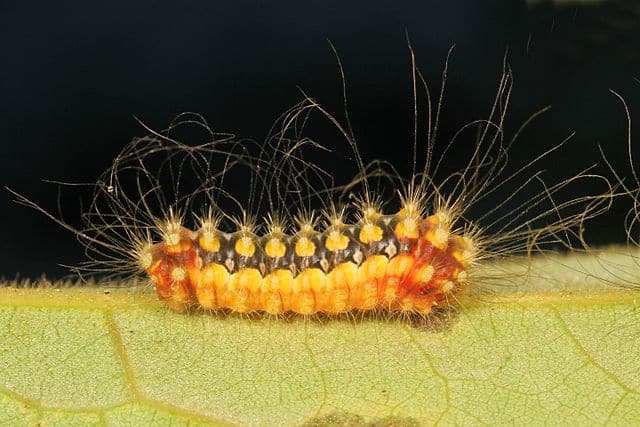
Family: Megalopygidae
Scientific name: Norape ovina
Found in: Northern & Central America
Host plant: Hackberry and redbud
Unlike other caterpillars from the family of flannel moths (megalopygidae), the White Flannel Moth Caterpillar doesn’t look like a fluffy ball of hair. Instead, it has a yellow body with a black stripe along it’s back. The front and back of its body are marked with red.
These caterpillars are fairly small, growing up to be about 1 inch long as adults. Getting stung by one of these caterpillars will most likely cause a rash, which should subside within a day or two.
#6 Hag Moth
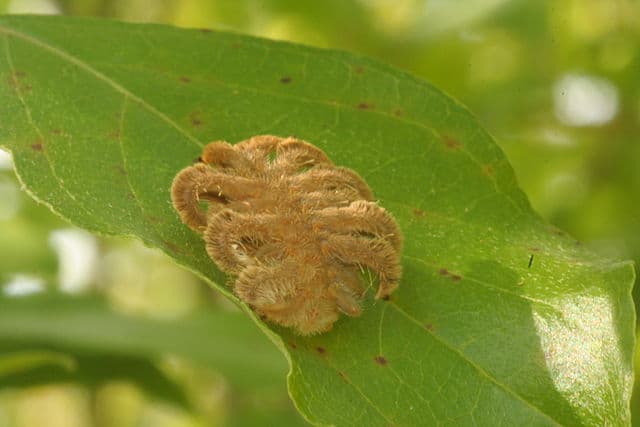
Family: Liumacocidae
Scientific name: Phobetron pithecium
Found in: North America
Host plants: Various woody plants including oak and apple
The Hag Moth Caterpillar is also sometimes called the Monkey Slug, and you’ll definitely recognize it easily! They have 9 “arms” on each side, all covered with hairs. These caterpillars often hide on the underside of leaves, which is why you might accidentally touch one.
Touching one of these funny creatures might cause burning, itching, and redness. Allergic reactions are rare, but possible, in which case the reaction might be stronger.
#7 Stinging Rose Caterpillar
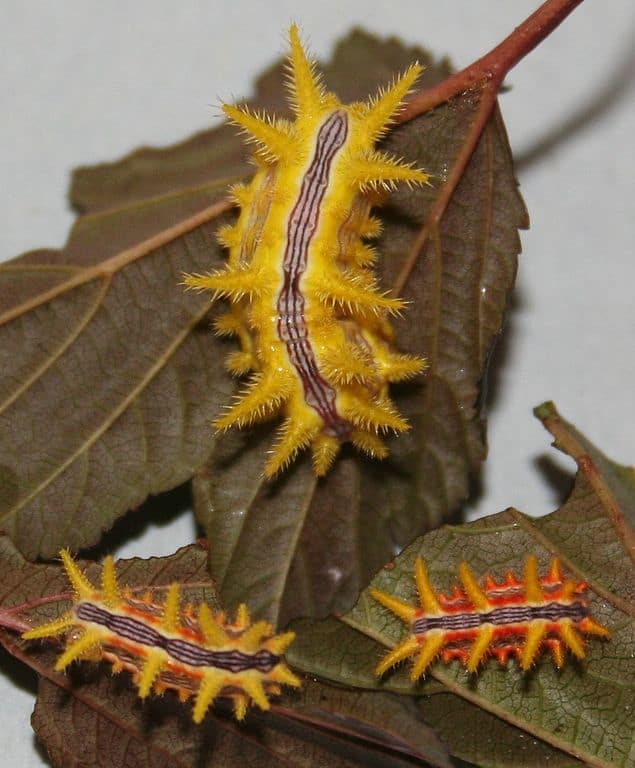
Family: Limacodidae
Scientific name: Parasa indetermina
Found in: Eastern US
Host plants: Redbud, oak, hickory & some other bushes and trees
Stinging rose caterpillars look fascinating, but don’t touch them! Just like with other stinging caterpillars, touching one of those might cause a serious itch on your skin. However, these are quite rare so you might even consider yourself lucky if you see one of those. After all, they are a site to behold! (just look at the photo above)
#8 Hickory Tussock Caterpillar
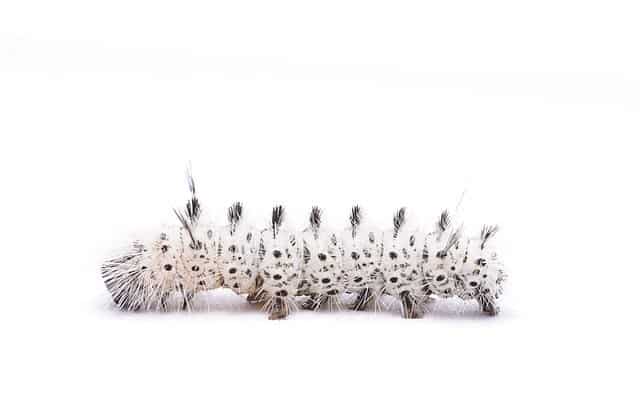
Family: Lophocampa
Scientific name: Lophocampa caryae
Found in: Ontario, Canada
Host plants: Mainly hickory, walnut, elm, & oak
Why do all the toxic caterpillars look so incredibly cute? We don’t know, but it might be their toxic hairs which they are covered in. This is certainly true when it comes to the Hickory Tussock Caterpillar, which is full of these tufts of ‘hairs’. The body of the caterpillar is black and white.
Most commonly found in late summer & early autumn, these caterpillars are known to cause an annoying itchy rash. Most of the time, the rash should disappear within a day or two, but if it doesn’t, it’s best to talk to a doctor.
#9 American Dagger Caterpillar
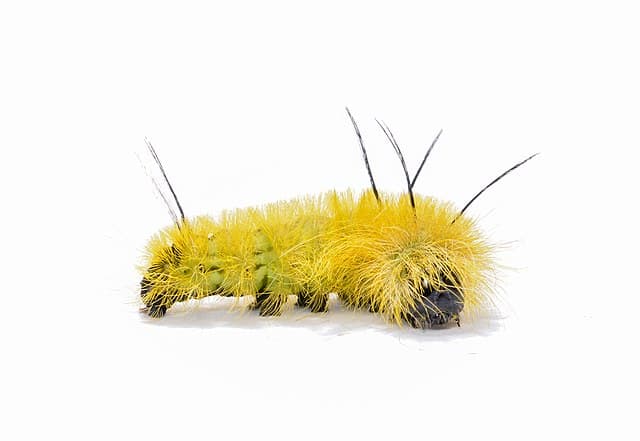
Family: Acronicta
Scientific name: Acronicta americana
Found in: Eastern US
Host plants: Various trees, including oak & elm
The American Dagger Caterpillar is small and yellowish-green. It is covered in yellowish-green hairs, but these are actually just hairs, which are harmless. The toxic part actually comes from the black spines which you’ll notice poking through the yellow hairs if you look closely.
Just like most other species on this list, touching one of those yellow creatures can cause a painful and annoying rash.
#10 Pine Processionary Caterpillar
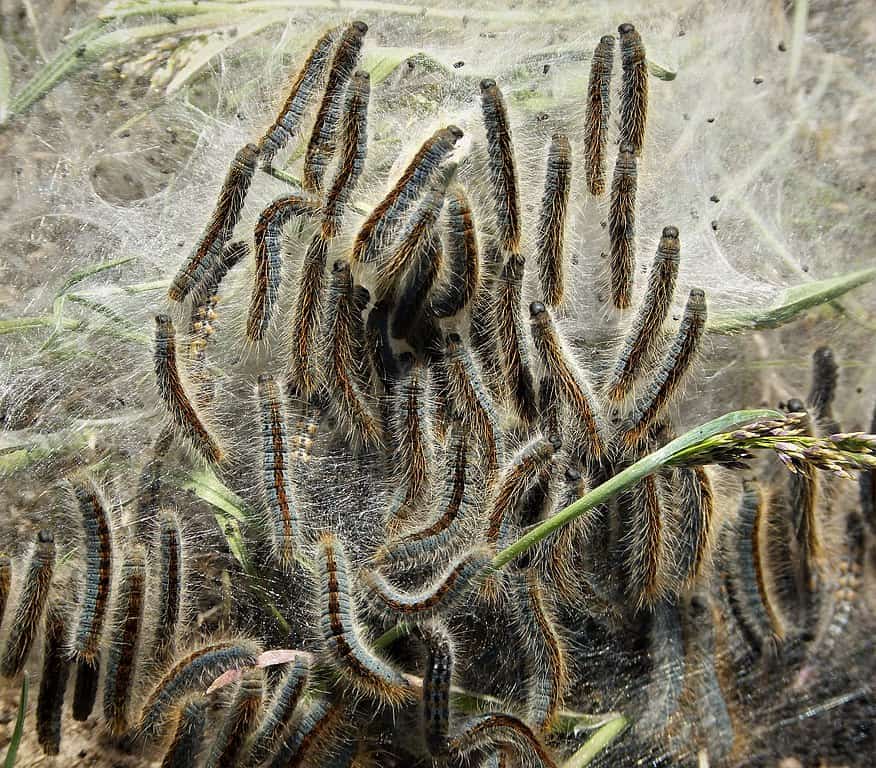
Family: Notodontidae
Scientific name: Thaumetopoea pityocampa
Found in: Europe, North Africa, Middle East
Host plants: Pine trees
The Pine Processionary Moth Caterpillars (as well as their cousings Oak Processionary Moth Caterpillars which nest on oak trees) are one of the most annoying toxic caterpillars.
This is because they nest on their favorite trees in large numbers. When disturbed, these caterpillars can eject their stinging hairs in large numbers, which can hurt unsuspecting victims. This can cause irritation of skin and the eyes. Luckily, serious allergic reactions are rare, although possible.
Final Thoughts
That’s it for this article! As you’ve seen, some caterpillars like the Southern Flannel Moth Caterpillar can be quite dangerous! Nobody wants to get stung by such a creature. However, most caterpillars are not terribly dangerous, although they might cause an annoying itch for a couple of days, so there is no reason to worry too much about it.
To learn more about the world of insects, check out these articles too:
The Color of Caterpillars – Green, Yellow, Black, Blue and More!
How to Choose The Best Pet Bug FOR YOU
Can Pest Control Get Rid of Gnats?
Sources
Entomology at the University of Kentucky. Stinging Caterpillars. Retrieved Jan 21, 2023. https://entomology.ca.uky.edu/ef003
University of Florida IFAS Extension. Stinging and Venomous Caterpillars of the Southeast. Retrieved Jan 21, 2023. https://edis.ifas.ufl.edu/publication/IN014
University of Arkansas Arthropod Museum. Stinging Rose Caterpillar. Retrieved Jan 21, 2023. https://arthropod.uark.edu/stinging-rose-caterpillar/
Seldeslachts, Andrea, Steve Peigneur, and Jan Tytgat. “Caterpillar venom: A health hazard of the 21st century.” Biomedicines 8.6 (2020): 143.
Villas-Boas, Isadora Maria, Giuliano Bonfa, and Denise V. Tambourgi. “Venomous caterpillars: from inoculation apparatus to venom composition and envenomation.” Toxicon 153 (2018): 39-52.
Michienzi, Avery E., et al. “The sting of a white flannel moth caterpillar (Novape ovina).” Wilderness & Environmental Medicine (2022).
Recent Posts
Tiny Black Bugs in Bathroom NO WINGS: What They Are and What to Do!
Finding tiny black bugs in your bathroom can be uncomfortable, to say the least. Especially if they are persistent, or they appear in very large numbers, which they often like to do. When it...
Tiny Black Bugs in Plant Soil - What Are They & What To Do About It
A short horror story: You get a new houseplant. You do your best to take care of it. You’ve ensured that it has the right soil, the right amount of sun, it gets enough water. And then one day, you...

